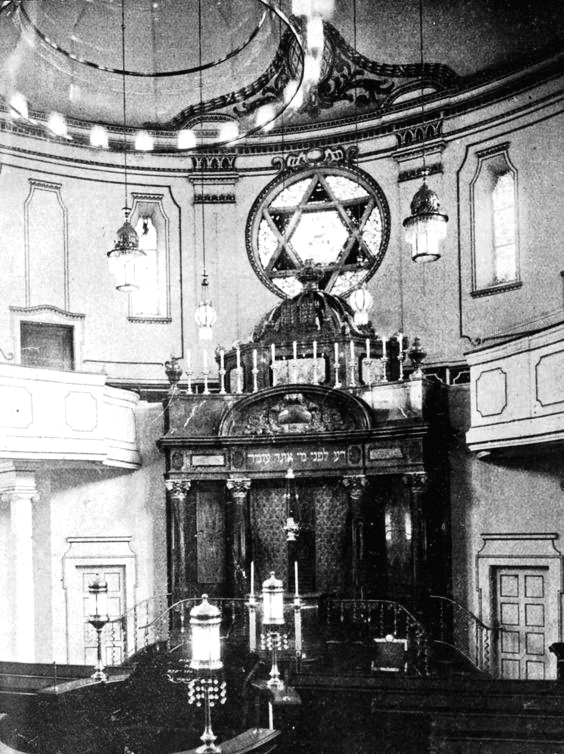The Transylvanian Jews Before the Holocaust
- RCI USA
- Jan 27, 2022
- 4 min read
An online exhibition

Photo 1: Holocaust Museum of Northern Transylvania in Șimleu Silvaniei founded in the now restored old Synagogue
On the International Holocaust Remembrance Day, we pay tribute to the life and memory of the once thriving Jewish community of Transylvania, almost completely obliterated towards the end of the Second World War, whose fate is commemorated by a unique institution located in the heart of Romania, the Holocaust Museum of Northern Transylvania in Șimleu Silvaniei.
We follow the saga of the establishment of the museum, which occupies a derelict synagogue now restored to its former glory, and examine the destiny of the Transylvanian Jewry in the company of Dr. Alex Hecht, the museum’s founder, Daniel Stejeran, the museum’s director, Dr. Ana Bărbulescu, head of the research department of the Elie Wiesel National Institute for Studying the Holocaust in Romania, and author and academic Dr. Roberta Seret, founder of the International Cinema Education. With a keynote introduction by A.G. Weinberger, Vice President of the Romanian Cultural Institute.
The discussion, moderated by RCI New York director Dorian Branea, will be preceded by the screening of the documentary "The Right to Be" by Edward Staroselsky, which presents the story of the creation of the Holocaust Museum in Northern Transylvania and its main exhibition, narrating the life of the vanished community from the relative peace before the war to its almost total destruction in the Holocaust.
You can watch the film and follow the discussion HERE.
Jewish Communities Before the Holocaust
Before the Nazis seized power in 1933, Europe had a richly diverse set of Jewish cultures, many of which were dynamic and highly developed, that drew from hundreds and, in some areas, a thousand or more years of Jewish life on the continent. In little more than a decade, most of Europe would be conquered, occupied, or annexed by Nazi Germany and its Axis partners, and the majority of European Jews – two out of every three – would be dead.

Photo 2: Students during a training session at the weaving workshop of the Sighet Yeshiva, “Mosad Tora VeHaim”, approx. 1920-1935
Photo 3: . Members of the Klein Kupferman family take a boat ride in Crikvenica, Croatia, 1933
Photo 4: The children of an extended Lithuanian Jewish family poses on top of a haystack
Photo 5: Group portrait of Jewish couples from the Balkans on board a ship during a sightseeing excursion to Palestine
Photo 6: Portrait of a Yugoslav Jewish family living in Romania, 1930-1931
Photo 7: The weaving workshop students and staff of the Sighet Yeshiva, ‘Mosad Tora VeHaim’. In first row, left to right: master craftsman M. Segal, senior Rabbi I. L. Gross, and the bookkeeper H. Stein, approx. 1920-1935
Photo 8: A group of Hasidic Jews in a Jewish cemetery in Sighet, before May 1944. Among those pictured is Rabbi Yehuda Teitelbaum (left, wearing a scarf)
Photo 9: Group portrait of the Stern family in front of their home in Vișeul de Mijloc, 1934

Photo 10: Csengeri family from Şimleu Silvaniei before 1944
Jewish Children Before the Holocaust

Photo 11: Group portrait of young school children in Șimleu Silvaniei
Photo 12: Two jewish children, Romania, 1939
Photo 13: Group portrait of children dressed in tutus at a ballet class in Cluj-Napoca
Photo 14: Prewar family portrait of Malchi Deutsch (nee Davidovich), cousins of Rose Dratler, Transylvanian Jews

Photo 15: Twin sisters Yehudit and Lea Csengeri from Șimleu Silvaniei pose together holding hands in their bathing suits. Both sisters survived Auschwitz and the experiments of dr. Mengele. In 2015 they came back to Transylvania and visited Șimleu for the fist time in over 70 years
Jewish Education

Photo 16: Pupils of the Jewish Gymnasium in Cluj, Romania, 1942-1952
Photo 17: Pre-war Jewish address cards, Lublin. Scenes from the Lublin Ghetto. Society for the Preservation of Jewish Heritage in Lublin, Poland
Photo 18: Pre 1944 Jewish children in classroom
Jewish Synagogues and Aspects of the Religious Life

Photo 19: The great synagogue of Şimleu Silvaniei before the war
Photos 20-21: Jewish men praying
Photo 22: Hindenburg, Germany. A pre-war synagogue
Photo 23: The Ark and Bima in the Regensburg Synagogue
Photo 24: A synagogue in Warsaw, Poland
Portraits of Transylvanian Jewish Families Before 1944

Photo 25: Group of young people in the summer of 1943 in Nuşfalău in the Hecht family backyard. All adult males were laborers who worked and ate at the Hecht House because of availability of Kosher food
Top row standing, right to left – first girl – Ruchel Hecht; third girl – Raizel Hecht; fourth girl – Evike Hecht; fifth girl – Saci Hecht; sixth girl – Lili Hecht
Second row sitting, right to left – first girl – Eva Hecht
The little girl and little boy in the picture are Eva Hecht’s sister and brother
Of the Hecht Family members in the picture, the following were murdered in Auschwitz after deportation from the Cehei Ghetto on May 29, 1944: Rachel Hecht, Raizel Hecht, Lili Hecht and Eva Hecht’s little brother
Photo 26: Elly and Adalbert Berkovits from Șimleu Silvaniei. The picture of Adalbert, born in March 1939, was taken two years before he was killed at Auschwitz, in 1944. Elly survived to tell the story and still lives in New York City. She is the author of Elly: My True Story of the Holocaust. She took part in an event dedicated to the International Holocaust Remembrance Day and organized in 2020 by the Romanian Cultural Institute in New York

Photo 27: Elly Berkovits Gross, together with the American Jewish Joint Distribution Committee Vice President Jane G. Weitzman, at the Romanian Cultural Institute in New York, February 2020
Photos 28-31: Jewish families in Transylvania before the war

The photographs included in this online exhibition have been offered for publication to the Romanian Cultural Institute in New York by the Holocaust Museum of Northern Transylvania.













































